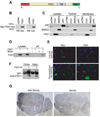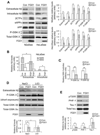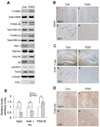A functional mouse retroposed gene Rps23r1 reduces Alzheimer's beta-amyloid levels and tau phosphorylation
- PMID: 19914182
- PMCID: PMC3846276
- DOI: 10.1016/j.neuron.2009.08.036
A functional mouse retroposed gene Rps23r1 reduces Alzheimer's beta-amyloid levels and tau phosphorylation
Abstract
Senile plaques consisting of beta-amyloid (Abeta) and neurofibrillary tangles composed of hyperphosphorylated tau are major pathological hallmarks of Alzheimer's disease (AD). Elucidation of factors that modulate Abeta generation and tau hyperphosphorylation is crucial for AD intervention. Here, we identify a mouse gene Rps23r1 that originated through retroposition of ribosomal protein S23. We demonstrate that RPS23R1 protein reduces the levels of Abeta and tau phosphorylation by interacting with adenylate cyclases to activate cAMP/PKA and thus inhibit GSK-3 activity. The function of Rps23r1 is demonstrated in cells of various species including human, and in transgenic mice overexpressing RPS23R1. Furthermore, the AD-like pathologies of triple transgenic AD mice were improved and levels of synaptic maker proteins increased after crossing them with Rps23r1 transgenic mice. Our studies reveal a new target/pathway for regulating AD pathologies and uncover a retrogene and its role in regulating protein kinase pathways.
Figures







Similar articles
-
The Rps23rg gene family originated through retroposition of the ribosomal protein s23 mRNA and encodes proteins that decrease Alzheimer's beta-amyloid level and tau phosphorylation.Hum Mol Genet. 2010 Oct 1;19(19):3835-43. doi: 10.1093/hmg/ddq302. Epub 2010 Jul 22. Hum Mol Genet. 2010. PMID: 20650958 Free PMC article.
-
RPS23RG1 reduces Aβ oligomer-induced synaptic and cognitive deficits.Sci Rep. 2016 Jan 6;6:18668. doi: 10.1038/srep18668. Sci Rep. 2016. PMID: 26733416 Free PMC article.
-
β2 adrenergic receptor, protein kinase A (PKA) and c-Jun N-terminal kinase (JNK) signaling pathways mediate tau pathology in Alzheimer disease models.J Biol Chem. 2013 Apr 12;288(15):10298-307. doi: 10.1074/jbc.M112.415141. Epub 2013 Feb 19. J Biol Chem. 2013. PMID: 23430246 Free PMC article.
-
Current advances on different kinases involved in tau phosphorylation, and implications in Alzheimer's disease and tauopathies.Curr Alzheimer Res. 2005 Jan;2(1):3-18. doi: 10.2174/1567205052772713. Curr Alzheimer Res. 2005. PMID: 15977985 Review.
-
Tau therapeutic strategies for the treatment of Alzheimer's disease.Curr Top Med Chem. 2006;6(6):579-95. doi: 10.2174/156802606776743057. Curr Top Med Chem. 2006. PMID: 16712493 Review.
Cited by
-
CutA divalent cation tolerance homolog (Escherichia coli) (CUTA) regulates β-cleavage of β-amyloid precursor protein (APP) through interacting with β-site APP cleaving protein 1 (BACE1).J Biol Chem. 2012 Mar 30;287(14):11141-50. doi: 10.1074/jbc.M111.330209. Epub 2012 Feb 17. J Biol Chem. 2012. PMID: 22351782 Free PMC article.
-
Nasal Delivery of D-Penicillamine Hydrogel Upregulates a Disintegrin and Metalloprotease 10 Expression via Melatonin Receptor 1 in Alzheimer's Disease Models.Front Aging Neurosci. 2021 Apr 15;13:660249. doi: 10.3389/fnagi.2021.660249. eCollection 2021. Front Aging Neurosci. 2021. PMID: 33935689 Free PMC article.
-
Complex Analysis of Retroposed Genes' Contribution to Human Genome, Proteome and Transcriptome.Genes (Basel). 2020 May 12;11(5):542. doi: 10.3390/genes11050542. Genes (Basel). 2020. PMID: 32408516 Free PMC article.
-
Cancer, Retrogenes, and Evolution.Life (Basel). 2021 Jan 19;11(1):72. doi: 10.3390/life11010072. Life (Basel). 2021. PMID: 33478113 Free PMC article. Review.
-
The Rps23rg gene family originated through retroposition of the ribosomal protein s23 mRNA and encodes proteins that decrease Alzheimer's beta-amyloid level and tau phosphorylation.Hum Mol Genet. 2010 Oct 1;19(19):3835-43. doi: 10.1093/hmg/ddq302. Epub 2010 Jul 22. Hum Mol Genet. 2010. PMID: 20650958 Free PMC article.
References
-
- Ancolio K, Dumanchin C, Barelli H, Warter JM, Brice A, Campion D, Frebourg T, Checler F. Unusual phenotypic alteration of beta amyloid precursor protein (betaAPP) maturation by a new Val-715 --> Met betaAPP-770 mutation responsible for probable early-onset Alzheimer’s disease. Proc. Natl. Acad. Sci. USA. 1999;96:4119–4124. - PMC - PubMed
-
- Barelli H, Lebeau A, Vizzavona J, Delaere P, Chevallier N, Drouot C, Marambaud P, Ancolio K, Buxbaum JD, Khorkova O, et al. Characterization of new polyclonal antibodies specific for 40 and 42 amino acid-long amyloid beta peptides: their use to examine the cell biology of presenilins and the immunohistochemistry of sporadic Alzheimer’s disease and cerebral amyloid angiopathy cases. Mol. Med. 1997;3:695–707. - PMC - PubMed
-
- Buee L, Bussiere T, Buee-Scherrer V, Delacourte A, Hof PR. Tau protein isoforms, phosphorylation and role in neurodegenerative disorders. Brain Res. Brain Res. Rev. 2000;33:95–130. - PubMed
Publication types
MeSH terms
Substances
Grants and funding
LinkOut - more resources
Full Text Sources
Other Literature Sources
Medical
Molecular Biology Databases

